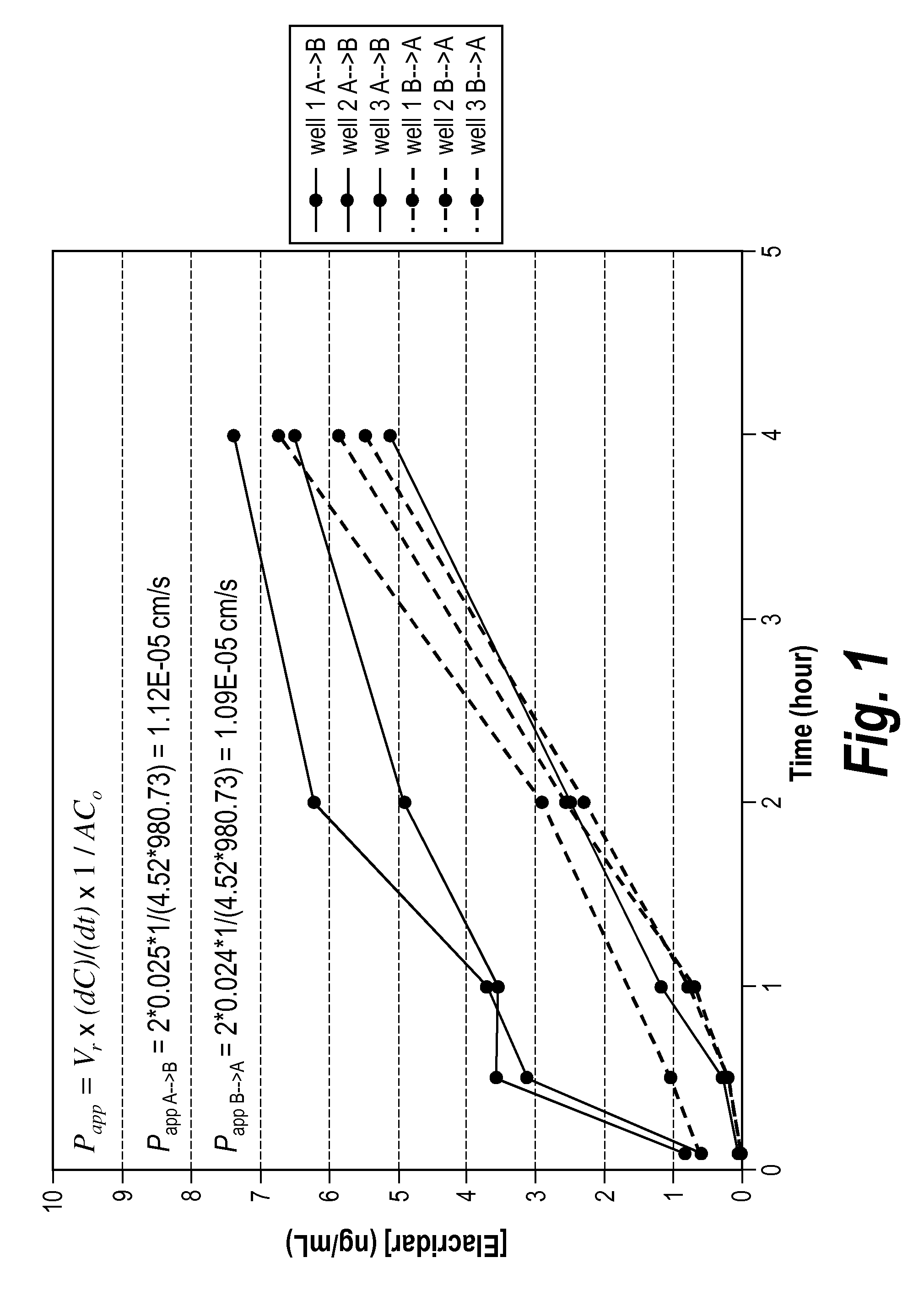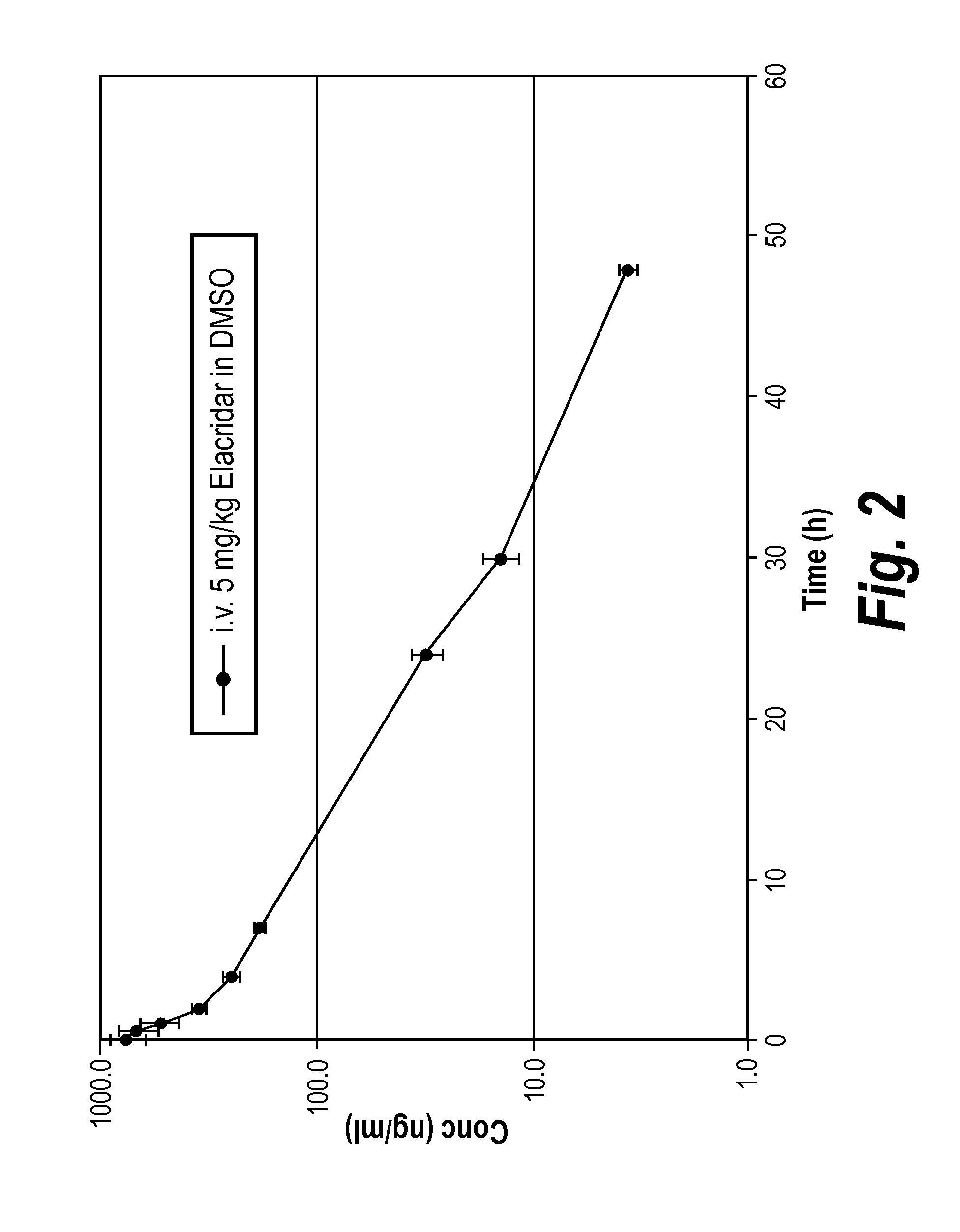Efflux inhibitor compositions and methods of treatment using the same
a technology of compositions and inhibitors, applied in the field of compositions, can solve the problems of not being able to deliver potentially useful therapeutic agents, no proven drug treatment for nf1, blood-brain and blood-nerve barriers, etc., and achieve the effect of enhancing the permeability of the blood-brain barrier and/or the blood-nerve barrier
- Summary
- Abstract
- Description
- Claims
- Application Information
AI Technical Summary
Benefits of technology
Problems solved by technology
Method used
Image
Examples
example 1
Nanoparticle Formulations of Elacridar
[0134]Various nanoparticle formulations of elacridar were made as detailed in Table 1 below:
TABLE 1Nanoparticle formulations of ElacridarElacridarHClStabilizer 1Stabilizer 2DmeanFormulation(w / w %)(w / w %)(0.05%) (w / w %)(nm)15%PVP K29 / 32Sodium docusate169(1.5%)25%HPMC 603Sodium docusate186(1.5%)35%Plasdone S630Sodium docusate161,000(1.5%)45%Tween 80—180(1.0%)55%Pluronic F127—108(1.0%)
[0135]Specifically, each formulation was each processed in a roller mill (US Stoneware model 755), in which each formulation was milled in a 20 mL glass bottle of 30 mm diameter for 3 days at 192 rpm. Each bottle contained 5 g of formulation and 36.5 g of Yttria Zirconia ceramic milling media of 0.8 mm diameter. The formulations were separated from the milling media and thereafter evaluated by examining their mean particle size distribution using a Horiba LA-950 laser light diffraction particle sizing instrument.
[0136]Nanoparticle sizes for the various formulations we...
example 2
Nanoparticle Manufacture
[0138]Nanoparticles formulations 2 and 5 from example 1 were prepared using a stirred media mill. Each formulation was processed in a custom built vertical media mill consisting of al 0 mL stainless steel mill chamber equipped with a smooth agitator shaft. About 4.5 g of formulation and about 5.5 g of milling media were charged into the milling chamber and the mill was run at 5000 rpm for 30 min. The milling media consisted of 0.5 mm polystyrene beads.
[0139]After milling, the formulations were separated from the milling media and visually inspected. Formulations 2 and 5 were both free flowing, indicative of stable dispersions. The mean particle size distribution of formulations 2 and 5 was 140 and 110 nm, respectively, as measured using a Horiba LA-950 laser light diffraction particle sizing instrument.
[0140]The formulations were also evaluated in terms of morphology and dispersion using an Olympus BX51 microscope equipped with an oil immersion objective prod...
example 3
In Vitro Permeability of Elacridar
[0141]An in vitro permeability assay using the MDCK cell line was performed to investigate the ability of elacridar to cross cellular membranes. Experiments were performed essentially as described in van Breemen R B et al. Expert Opin Drug Metab Toxicol 2005; 1: 175-85 (which is incorporated by reference herein in its entirety), except that MDCK cells were employed rather than Caco-2 cells. Specifically, non-transduced MDCK cells, expressing only basal amounts of endogenous ABC-transporters, were seeded in the apical compartments of a 24 mm Transwell plate (3.0 μm Pore Polycarbonate Membrane Inserts) and incubated at 37° C. and 5.0% CO2 conditions until confluency was reached. Both apical-to-basolateral and basolateral-to-apical transport was analyzed in triplicate. To each donor compartment, 2 ml of Minimal Essential Medium (supplemented with 20% Fetal Bovine Serum) containing 1 μM elacridar and 50 nCi / ml (1.85 kBq / ml) 14C-inulin was added, while e...
PUM
| Property | Measurement | Unit |
|---|---|---|
| Fraction | aaaaa | aaaaa |
| Fraction | aaaaa | aaaaa |
| Fraction | aaaaa | aaaaa |
Abstract
Description
Claims
Application Information
 Login to View More
Login to View More - R&D
- Intellectual Property
- Life Sciences
- Materials
- Tech Scout
- Unparalleled Data Quality
- Higher Quality Content
- 60% Fewer Hallucinations
Browse by: Latest US Patents, China's latest patents, Technical Efficacy Thesaurus, Application Domain, Technology Topic, Popular Technical Reports.
© 2025 PatSnap. All rights reserved.Legal|Privacy policy|Modern Slavery Act Transparency Statement|Sitemap|About US| Contact US: help@patsnap.com



